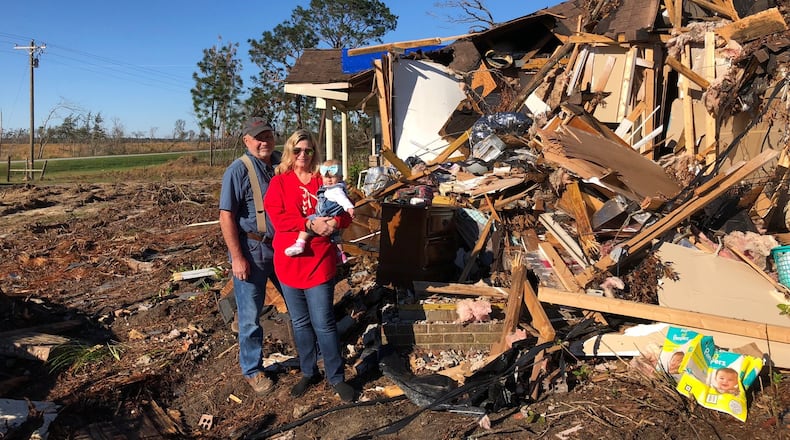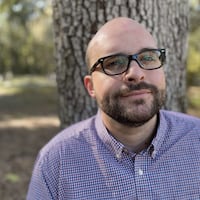Southwest Georgia isn’t just hurt after Hurricane Michael — it’s changed.
A month after the storm struck on Oct. 11, residents are still living in hotels and seeking help to repair homes battered by mighty oaks and pines in the pounding 115 mph winds. People are trying to move on, though many must lead different lives in the bruised landscapes of Colquitt, Bainbridge, Blakely and Donalsonville, where they can hardly open their eyes without seeing something broken.
“This is not something people are going to get over in a few months or a few years,” said Miller County volunteer firefighter and farmer John Edward Wells, who is among the storm’s victims. It’s “life-changing.”
State legislators will convene Tuesday for a special session to, among other things, consider $270 million in funding for the recovery, much of it for removal of debris, which is still piled in giant mounds on roadsides all over the region.
Hurricane Michael killed more than 20 people, including one in Georgia — 11-year-old Sarah Radney, who died when the wind skipped off Lake Seminole and threw a metal post into her grandparents' house.
Georgia farmers lost an estimated nearly $3 billion in ruined crops, including peanuts, pecans and cotton. The damage to homes was slow to be quantified, but vast.
More than 30,000 residents who had property damage, Wells included, have requested assistance from the Federal Emergency Management Agency. Some 70,000 Georgians, Wells also included, have also filed residential and agricultural insurance claims. The USDA announced Monday it was offering food stamps for residents who normally aren’t eligible.
FEMA has opened help centers across a 20-county region declared a disaster zone by President Donald Trump, offering help with temporary housing, home repairs and replacing damaged property. In recent days, long lines were still forming at supply centers stocked with food, cleaning products, bottled water and the blue tarps seen atop more cracked roofs than anyone could ever count.
Though hurricanes tend to be judged in casualties, people across southwest Georgia know much of the impact is also more subtle, felt in small moments when they think of the memories tied up in a home now destroyed, or when they see their child despondent, or when they look around and realize their town is just different.
Destruction spreads
On the night of the storm, Wells, 61, was at the all-volunteer fire department, where he’s the assistant chief, in Colquitt. Like all the other towns in the region, the city is an old agricultural community. Outside of the rustic downtown it’s sparsely populated, with long lonely swaths of piney woods and farms speckled with houses and mobile homes.
Wells’ wife, family and more than 100 others sought shelter inside Colquitt’s First Baptist Church — thought to be the strongest structure in town. During the height of the storm, Wells recalls feeling stunned as he watched a carport tumbling, fast, toward the church until it suddenly got caught on a power line and stopped. As the winds howled, the steeple tore off, crashing into someone’s truck. Despite the scares, the big brick church kept everyone inside safe.
After the storm passed, Wells helped rescue residents trapped in their homes before he climbed in his pickup truck and drove through the blacked-out county to check on his place. He saw a massive red oak that had somehow lived long enough to grow more than 3 feet wide had finally found reason to fall — on his home, smashing through the roof and the brick walls. It destroyed a full third of the home, where he and his wife who died of cancer had raised their kids, where he now lived with his new wife.
Tears welled in his eyes.
‘Can’t believe that storm did this’
The next morning, daylight revealed devastation all over southwest Georgia, where most counties have poverty rates of between 20 and 40 percent — more than double the state average. With power out for days and in many cases nearly two weeks, residents took cold showers if they could find a place with water, and ate freeze-dried emergency meal kits delivered by National Guard troops.
Even now, when the debris has at least been removed from roads, the damage can’t be ignored.
At the Dairy Queen in Blakely, even if you treat yourself to a dipped cone, you’ll still look out the front window and see ancient pecan trees toppled against the sky, which seems endless with so much of the woods gone. If you’re Tamika Smith, a mother of three young daughters, you stand in the living room of your mobile home and see a hole big as a golf cart in the ceiling, and, in the yard, your girls can see their trampoline busted under a tree, accompanied by the neighbor kids’ busted trampoline.
Smith and about everyone she knows in Blakely have been relying on FEMA and other agencies for weeks for groceries, help with home repairs and untying the myriad other knots the storm tied for them in the days when they couldn't work. This week, FEMA announced it was partnering with the state to hire residents in various positions to assist with relief efforts.
As stressful as the recovery has been for adults, it has been bewildering for children. Smith sees it in her 14-year-old, the oldest of the three girls.
"I see her staring at the ceiling every day — every day," the mom said. "She looks up at it and says she just can't believe that storm did this."
Helping and asking for help
Renee Spence, a perpetual volunteer who wears a cross around her neck, agreed to manage a supply center stocked by FEMA and other agencies in Colquitt.
Her husband Toby, a Desert Storm veteran, said he felt taken back to Kuwait by the “war zone” Hurricane Michael left behind in Miller County. But the Spences felt lucky because their house stood up well. They’ve seen people still living in trailers crushed by trees. Everywhere they turn, they see neighbors who haven’t been able to return to normal for one reason or another.
The wife pulled out a log book at the supply center, showing more than 100 people have come by most days for canned goods, soap, bottled water.
“We went through the shock of what happened,” she said, suddenly stopping as tears formed, glistening on her eye shadow. “Now everybody’s adjusting.”
Outside, several dozen were in line.
A lot of people around here don’t like to ask for help, but a time comes for everyone.
Trauma continues
Generally speaking, Wells said he feels like a blessed man.
But he gets overwhelmed sometimes at the house, which is on a road lined with snapped pines, huge timber forests that were as good as money in the bank until Hurricane Michael. Wells lost 75 acres of pines he planned to harvest for his retirement.
The red oak crushed two bedrooms and their contents: beds, family pictures, trinkets, diplomas, Bibles. The home is where so many memories of Wells’ late wife are grounded, for him and especially their grown daughters, who feel like she’s a little more gone now. She died of colon cancer in 2005.
“I’d say this is probably the second worst thing that’s ever happened to me,” Wells said in the front yard.
His wife Marianne walked over with their baby granddaughter, Maddie, who wore a big blue bow on her head and seemed to be smiling.
The couple, who are living at Marianne’s daughter’s place, talked about how fortunate they are to live in a small town where everyone lends a hand. They’re trying to remember to be thankful.
Wells extended a finger to Maddie’s face and smiled, cooing.
HOW TO HELP
FEMA encourages residents who want to help southwest Georgia residents to go through Voluntary Organizations Active in Disaster.
• To make a financial donation, you can find a list of charities working in the area at gavoad.communityos.org.
• To offer goods, visit nvoad.org or contact the American Red Cross at offersdesk@redcross.org.
• To donate labor, contact one of the nonprofits on VOAD’s list directly or go through VOAD at nvoad.org.
In other news:
About the Author
The Latest
Featured



